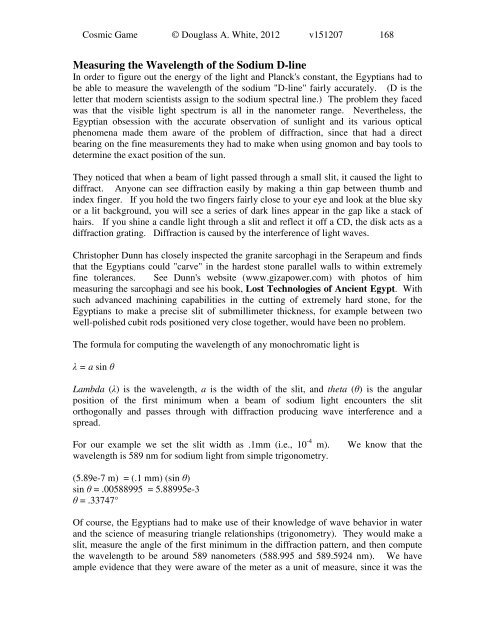Create successful ePaper yourself
Turn your PDF publications into a flip-book with our unique Google optimized e-Paper software.
<strong>Cosmic</strong> <strong>Game</strong> © Douglass A. White, 2012 v151207 168<br />
Measuring the Wavelength of the Sodium D-line<br />
In order to figure out the energy of the light and Planck's constant, the Egyptians had to<br />
be able to measure the wavelength of the sodium "D-line" fairly accurately. (D is the<br />
letter that modern scientists assign to the sodium spectral line.) <strong>The</strong> problem they faced<br />
was that the visible light spectrum is all in the nanometer range. Nevertheless, the<br />
Egyptian obsession with the accurate observation of sunlight and its various optical<br />
phenomena made them aware of the problem of diffraction, since that had a direct<br />
bearing on the fine measurements they had to make when using gnomon and bay tools to<br />
determine the exact position of the sun.<br />
<strong>The</strong>y noticed that when a beam of light passed through a small slit, it caused the light to<br />
diffract. Anyone can see diffraction easily by making a thin gap between thumb and<br />
index finger. If you hold the two fingers fairly close to your eye and look at the blue sky<br />
or a lit background, you will see a series of dark lines appear in the gap like a stack of<br />
hairs. If you shine a candle light through a slit and reflect it off a CD, the disk acts as a<br />
diffraction grating. Diffraction is caused by the interference of light waves.<br />
Christopher Dunn has closely inspected the granite sarcophagi in the Serapeum and finds<br />
that the Egyptians could "carve" in the hardest stone parallel walls to within extremely<br />
fine tolerances. See Dunn's website (www.gizapower.<strong>com</strong>) with photos of him<br />
measuring the sarcophagi and see his book, Lost Technologies of Ancient Egypt. With<br />
such advanced machining capabilities in the cutting of extremely hard stone, for the<br />
Egyptians to make a precise slit of submillimeter thickness, for example between two<br />
well-polished cubit rods positioned very close together, would have been no problem.<br />
<strong>The</strong> formula for <strong>com</strong>puting the wavelength of any monochromatic light is<br />
λ = a sin θ<br />
Lambda (λ) is the wavelength, a is the width of the slit, and theta (θ) is the angular<br />
position of the first minimum when a beam of sodium light encounters the slit<br />
orthogonally and passes through with diffraction producing wave interference and a<br />
spread.<br />
For our example we set the slit width as .1mm (i.e., 10 -4 m).<br />
wavelength is 589 nm for sodium light from simple trigonometry.<br />
We know that the<br />
(5.89e-7 m) = (.1 mm) (sin θ)<br />
sin θ = .00588995 = 5.88995e-3<br />
θ = .33747°<br />
Of course, the Egyptians had to make use of their knowledge of wave behavior in water<br />
and the science of measuring triangle relationships (trigonometry). <strong>The</strong>y would make a<br />
slit, measure the angle of the first minimum in the diffraction pattern, and then <strong>com</strong>pute<br />
the wavelength to be around 589 nanometers (588.995 and 589.5924 nm). We have<br />
ample evidence that they were aware of the meter as a unit of measure, since it was the





